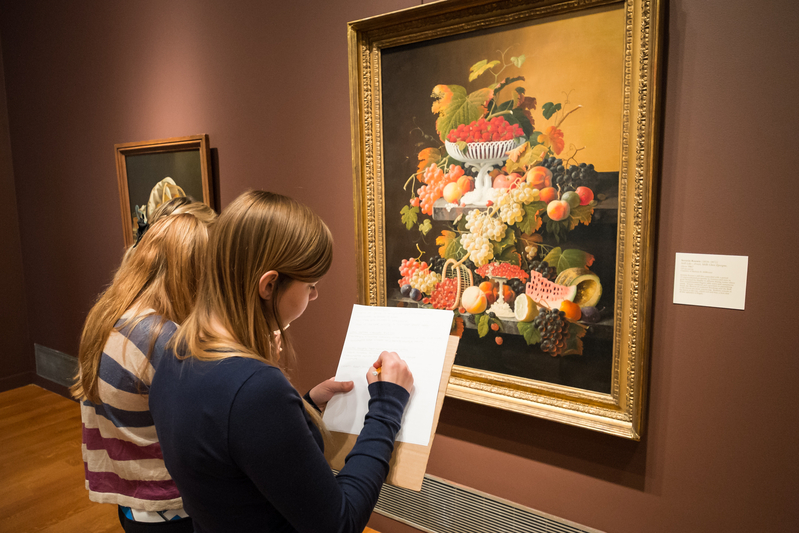Still life vs. real life
When sophomore Logan McClay heard his biology class was taking a field trip to Reynolda House Museum of American Art, he admits he was confused.
Biology professor Kathy Kron and the 11 students enrolled in Biology 105: Plants & People met at the museum to learn firsthand how biology is incorporated in the current exhibition, “Things Wondrous and Humble: American Still Life” at Reynolda House Museum of American Art.
Science and symbolism
Julia Hood, education coordinator for the Museum, first led the students to Audrey Flack’s painting, “Bounty.” She asked the students to look for clues to determine if the fruits and vegetables used were accurately depicted in color, shape and size.
 McClay and his peers were charged with deciding whether or not the fruits, vegetables or flowers used were to intended to represent still life or real life. The students immediately noticed that cherries seemed to be too red and the parrot was unrealistic in size and shape. Soon the carrots came into question. Unlike the vibrant plants in “Bounty,” the carrots were beginning to brown.
McClay and his peers were charged with deciding whether or not the fruits, vegetables or flowers used were to intended to represent still life or real life. The students immediately noticed that cherries seemed to be too red and the parrot was unrealistic in size and shape. Soon the carrots came into question. Unlike the vibrant plants in “Bounty,” the carrots were beginning to brown.
Artists make deliberate choices with the objects depicted in their art, said Hood. The students brought a biological perspective to their interpretation of the paintings, which helped them identify why a particular plant was used.
She explained a common technique used by artists is “memento mori,” a Latin phrase which means life will fade. Flack intentionally chose the carrots, which the students determined were not fresh like the other plants used in the painting, to show that death is inevitable.
“The students get the opportunity to learn biology through studying plants in a different context and understand their importance, whether symbolically or botanically,” said Kron. “Wake Forest is the ideal university to do this type of teaching because of the great access to fine art as well as classes in biology.”
Tailored tours
Kron, with the help of Elizabeth Chew, the Betsy Main Babcock Director of the Curatorial and Education Division at Reynolda House, customized her class’ field trip. As Chew explained, the Museum has worked with other classes across the University, from divinity to the medical school, to tailor each class visit.
“We hope to see more classes come through our doors because we want all disciplines to have the opportunity to experience the estate,” Chew said.
Before the exhibition tour concluded, McClay said he better understood the relevance of the exhibition to biology and the significance that a plant, like a carrot, could play in a piece of art.
“The exhibition was the perfect opportunity to combine arts and science. My goal is the next time the students look at a painting, they notice that plants are everywhere and that they are able to determine if the composition is symbolic in its details or is a scientific reproduction.”
Categories: Arts & Culture, Research & Discovery, University Announcements
Media Contact
Wake Forest News
media@wfu.edu
336.758.5237



